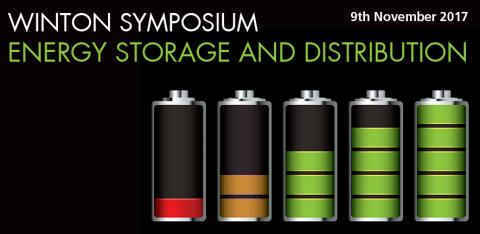
The sixth annual Winton Symposium was held on 9 November 2017 at the Cavendish Laboratory on the theme of “Energy Storage and Distribution”.
Storage and distribution of energy is seen as the missing link between intermittent renewable energy and reliability of supply. Current technologies that are being deployed have considerable headroom for improvements in performance, with the symposium speakers discussing some of the many new technologies that are being explored and how understanding the basic science of these can accelerate their development.
Professor Howard Wilson, Programme Director of the UK Atomic Energy Authority talked about the “Path to Delivering Fusion Power”. Our local nuclear reactor is the sun, but for fusion to be viable on earth it is necessary to recreate a system that is better than the sun, which requires an interdisciplinary collaboration of physical sciences, engineering and technology. Nuclear fusion is very attractive; there is plenty of fuel, no greenhouse gas emissions and the process is inherently safe as there is no chain reaction, there are however a number of challenges that need to be overcome.
Link to presentation "Path to Delivering Fusion Power"
Professor Katsuhiko Hirose joined Toyota Motor Corporation 35 years ago where he has been involved in two major innovation projects; the Prius electric hybrid vehicle and Miria hydrogen fuel cell vehicle. The ethos at Toyota for taking on these challenges is that to do nothing would incur greater risks. His presentation “Hydrogen as a vector toward the sustainable society” focused on the later project and the broader implications of moving towards a hydrogen based economy. He is currently a Professional Partner at Toyota and Visiting Professor at the International Institute for Carbon Neutral Energy Research, Kyushu University.
Link to presentation "Hydrogen as a vector toward the sustainable society"
Professor David Larbalestier, Director of the Applied Superconductivity Center, reviewed the “Prospects for the Use of Superconductors for Energy Storage and Distribution”. Low (LTS) and high (HTS) temperature superconductors are at the technical level for green energy applications; however for adoption a 'killer app' is required. One example is the generation of high magnetic fields, such as the work at the National High Magnetic Field Laboratory led by David, which requires clever materials engineering.
Link to presentation "Prospects for the Use of Superconductors for Energy Storage and Distribution"
Dr Munaf Rahimo gave a prospective on “Power semiconductors for grid system power electronics applications”, based on his experience at Asea Brown Boveri (ABB) where he is Corporate Executive Engineer in the Grid System Division. The company is enabling stronger (higher voltages), smarter (digital power management) and greener (smaller footprint with increasing contribution from renewable energy sources) grids.
Link to presentation "Power semiconductors for grid system power electronics applications"
Professor Rosa Palacín from the Institut de Ciència de Materials de Barcelona provided a brief history of battery technologies; from the early work of Volta in the late 1700’s to the Pb-acid and Ni-based batteries in 1800’s which are still in use today. The current battery technology of choice is Li-ion which was based on scientific studies of Li intercalation in the 1970’s and 80’s and commercialised by Sony in 1991. In her talk “Battery energy storage beyond Li-ion” she described some future options for batteries.
Link to presentation "Battery energy storage beyond Li-ion"
Professor David Greenwood, leads the Advanced Propulsions Systems Group at the Warwick Manufacturing Group. In his talk on “The future for zero emissions transport”, he discussed some of the trends in our travel needs and how these can be met in a sustainable manner. David predicted that the transition to zero emission passenger electric vehicles will take place in the next 20-30 years as research leads to performance and price improvements and in parallel the electricity source is de-carbonised.
Link to presentation "The future for zero emissions transport"

